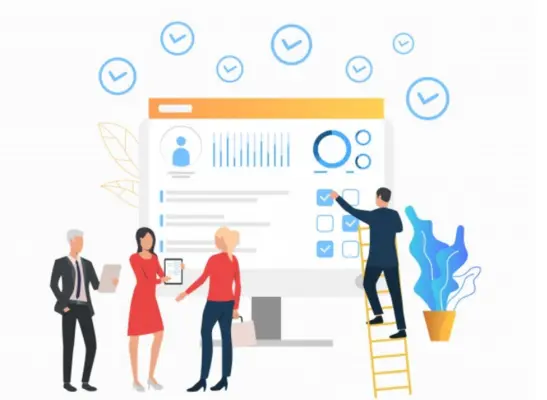Promoting inclusion in today’s fast-paced workplace is not only morally right but also tactically beneficial. Ensuring workplace accessibility involves more than just following the law; it also involves a dedication to empowerment and equity. Regardless of ability, every facet of organizational culture—from physical environments to digital resources—plays a critical role in ensuring that everyone may flourish and effectively contribute.
This vision needs to be realized through a diversified strategy. To identify and remove obstacles, thorough accessibility audits are the first step. From there, organizations must embrace cutting-edge tools for accessible document formats and integrate assistive technologies that empower employees to excel. Digital accessibility takes center stage, with websites and applications meticulously crafted to ensure seamless navigation for all users. Yet, genuine accessibility extends beyond digital interfaces; it permeates organizational policies and physical spaces. Embracing flexibility in work arrangements, alongside ongoing training initiatives, fosters an inclusive culture where every voice finds respect and acknowledgment. Companies that engrain accessibility into their core values not only meet legal mandates but also nurture an environment that treasures diversity and ignites innovation.
1: Conduct an Accessibility Audit
An accessibility audit is the first step toward understanding how your workplace stands in terms of inclusivity. To conduct a thorough assessment, it’s essential to delve into every facet of your company, from its internal policies to its digital footprint and physical layout. Partnering with accessibility experts ensures a comprehensive examination. These professionals don’t just spot obvious barriers like inaccessible entrances; they also uncover subtler issues like poorly lit areas for visually impaired individuals or digital content that isn’t screen reader-friendly. The aim is to craft a detailed action plan that addresses these challenges, ensuring every employee can seamlessly access, navigate, and utilize the workplace environment.
2: Utilize Tools for Accessible PDFs
Because PDFs are so common in today’s business environment, making sure they are readable is crucial. Because so many people interact with digital content through screen readers and assistive devices, accessibility becomes a critical issue. PDF remediation tools play a pivotal role in this process. By deploying tools that rigorously evaluate PDFs for accessibility, employers vastly improve document usability. This ensures compatibility with screen readers, descriptive image text, and keyboard navigation support. Such initiatives foster inclusivity and empower employees with disabilities, cultivating a workplace culture valuing diversity and accessibility.
3: Implement Assistive Technologies
Assistive technologies enable people with disabilities to perform well at work and are vital allies. Tools that reduce barriers and increase productivity include ergonomic aids and speech-to-text software. Businesses provide a positive work environment where everyone may thrive by welcoming such ideas and offering thorough training. Remaining at the forefront of assistive technology is imperative for organizations that value diversity, as it guarantees that every person gets the help they need to succeed.
4: Ensure Digital Accessibility
Accepting digital accessibility makes your information accessible to people with different abilities. This entails offering necessary functionalities including screen reader users’ clear identification of interactive parts, keyboard navigation that is easily accessible to people who are unable to use a mouse, and video subtitles for the hard of hearing or deaf. The Web Content Accessibility Guidelines (WCAG) provide a comprehensive framework for making digital content accessible. By embracing these standards, organizations create a digital landscape that embraces diversity and accessibility, allowing every team member to engage fully.
5: Adapt Physical Spaces
Going beyond the basics of ramps and accessible amenities, optimizing physical accessibility in the workplace involves creating flexible environments tailored to the diverse needs of employees with disabilities. This might entail providing customizable technology solutions, ergonomic seating choices, and adaptable workstations. Ensuring that all areas, including communal spaces like kitchens and meeting rooms, are easily accessible sends a clear message: every employee’s inclusion and participation are truly valued at every level of the organization.
6: Provide Flexible Work Options
As awareness of the benefits of flexible work arrangements grows, especially for employees with disabilities, their significance becomes increasingly apparent. Beyond traditional methods, like part-time roles and flexible schedules, embracing remote work options offers even greater flexibility. Providing individuals with disabilities the opportunity to personalize their home offices or work during non-traditional hours can significantly enhance their productivity and overall satisfaction.
7: Offer Accessibility Training
Forging a truly inclusive workplace transcends mere intentions—it hinges on empowering every individual with the knowledge and empathy essential for nurturing a supportive environment. Introducing immersive accessibility training for all staff members marks a pivotal milestone in this transformative journey, dismantling barriers and fostering authentic understanding. This training should delve into the nuances of different disabilities, encourage respectful interactions, and offer practical tips for making necessary adjustments. It should also empower employees to create accessible materials and communicate inclusively, ensuring that everyone feels valued and respected in the workplace.
8: Create Inclusive Communication
In cultivating an inclusive workplace, communication must be accessible to all. This involves providing alternative formats like Braille, large print, or audio recordings alongside traditional materials. In the realm of digital communications, ensuring accessibility is more than a priority—it’s a cornerstone. During meetings, going the extra mile to accommodate everyone, be it through captioning or sign language interpretation, becomes imperative. By embracing these practices wholeheartedly, the workplace blossoms into a space where every voice resonates with importance and is embraced wholeheartedly.
9: Establish an Accessibility Committee
Ignite your organization’s accessibility mission with a dynamic committee. The integration of varied viewpoints ignites advancement by identifying obstacles, inventing creative fixes, and promptly attending to the requirements of every worker.
10: Encourage Feedback and Continuous Improvement
Additionally, Setting off on the path to accessibility is a never-ending process that calls for constant assessment and modification. It is critical to involve every employee, including those with disabilities, in order to evaluate current procedures and identify areas for improvement. Also, Organizations may maintain their accessibility initiatives at the forefront of innovation and demonstrate their steadfast commitment to promoting the various requirements of their workforce by cultivating a culture of cooperation and feedback.
Conclusion
In closing, nurturing an environment that champions inclusivity, and respect. And empowerment is the cornerstone of creating an accessible workplace that transcends regulatory obligations. Understanding that diversity isn’t just a checklist item or fad, but rather a catalyst for organizational success, is crucial. By ingraining accessibility as a core principle, organizations can unleash the untapped potential of their teams, and ignite innovation. And foster a culture where every individual has the opportunity to flourish uniquely.
Also, Navigating the complexities of today’s workplace, the quest for accessibility extends far beyond a mere destination. It transforms into an ongoing odyssey characterized by constant adaptation and progress. Moreover, Cultivating a culture of candid communication, and actively seek input from our diverse team members. Staying ahead of emerging best practices is pivotal in ensuring that our accessibility endeavors remain agile and relevant amidst the evolving landscape of our workforce.
Creating an accessible workplace is a dynamic journey that is constantly evolving in the larger scheme of organizational progress. It is about creating a space where each person is valued, and empowered to share. Their special talents, and supported regardless of their ability. Businesses that provide an inclusive work environment not only improve the lives of their employees. but also create a dynamic, cross-cultural culture that has a lasting impact on society.



